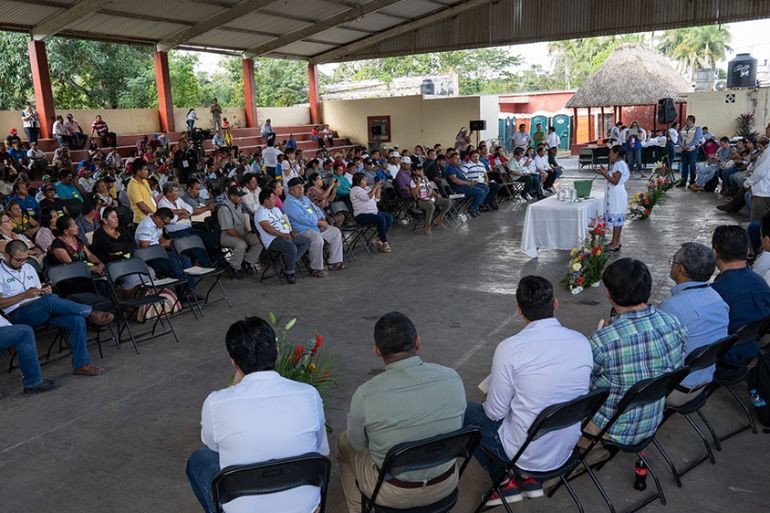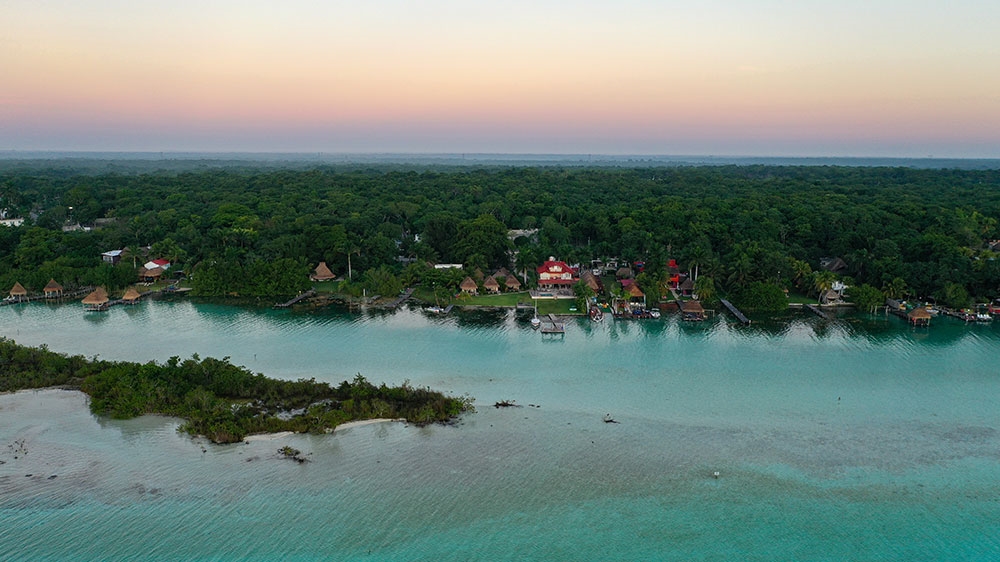Mexico holds assemblies to consider controversial Mayan Train
Some indigenous and environmental groups on Yucatan Peninsula worry project may bring more harm than good.

Mexico City, Mexico – The future of Mexican President Andres Manuel Lopez Obrador‘s ambitious Mayan Train (or Tren Maya) project hangs in the balance this weekend as the communities on the train’s proposed route express their thoughts about the plan.
The new 1,525-kilometre (948-mile) train route in Mexico’s Yucatan Peninsula is expected to connect nature reserves and archaeological zones in the impoverished southeast states of Chiapas, Tabasco, Quintana Roo and Campeche to the existing tourism hub of Cancun.
Keep reading
list of 4 itemsEcuador sues Mexico at ICJ over granting asylum to former vice president
Ecuador spat: Trotsky to the shah, Mexico’s long history as home to exiles
Ecuadorian tribunal deems arrest of former Vice President Glas illegal
Mexico‘s tourism board, the Fondo Nacional de Fomento al Turismo (FONATUR), has estimated the project will cost between $6-8bn. FONATUR expects the train to bring more than three million visitors a year to the region to see the area’s vast biodiversity, including the biospheres at Calakmul and Sian Ka’an.
But despite Lopez Obrador’s claim last year that the project “won’t uproot a single tree”, environmentalists have expressed their concerns over the project, and indigenous groups also worry about whether the government will adequately listen to the local communities’ concerns.
More than a dozen assemblies will be held in areas along the train’s proposed route this weekend. The assemblies will allow residents to tell the government about what they think of the route and overall project.
“It’s not about a ‘yes or no’ answer,” said Maritza Licona, a spokeswoman for the government’s Instituto Nacional de los Pueblos Indígenas (INPI), one of three state bodies overseeing the consultation. “If a community decides they don’t want the train on their land, we’ll change the route. If they want it stopped, we’ll stop.”

Jose Martin Naal, an ejido (or community) leader from Xkakoch in Campeche who attended the Tenabo consultation on Saturday, said his ejido welcomes the potential to increase tourism and allow members of his community to commute to find work. Other ejido leaders echoed Martin’s sentiments although several, including Pedro Raul Chi Canche from Calkini, expressed concerns about the amount and timing of any compensation that will be paid to those affected by the project.
The initial consultation phase saw conversations with 4,800 participants from 115 municipalities, Licona said, and took place over a four-week period beginning in November.
“We provided materials in Spanish and in four Indigenous languages,” she continued, “with broadcasts on 21 Indigenous radio stations.” Many who participated in the initial consultation spoke about the need to improve local infrastructure or to clarify the property rights of those affected by the project.
But the nature of the consultations has come under scrutiny.
‘We don’t have the power’
With photographs of apparent construction work on the site of the train circulating in local news earlier this week, questions have arisen about the consultation’s true function.
“The consultation is just about ‘listening to opinions’,” said a press release from El Consejo Civil Mexicano de Silvicultura Sostenible (CCMSS). “This violates the free will of the Maya people. We don’t have power to accept or reject anything.”
The CCMSS also says that the nature of the consultation breaches the International Labour Organization’s Convention 169, which protects indigenous populations.

It is a flaw that the government acknowledges.
“We want a constitutional reform that respects Convenio 169,” INPI spokeswoman Licona told Al Jazeera. “Until then, we have to follow protocols to the best of our ability.”
An INPI spokesman at the Tenabo consultation in Campeche on Saturday confirmed that the process will not end this weekend and the conversation will be an “ongoing conversation”.
But according to Leo Agusto, a left-leaning columnist with El Grafico: “These consultations aren’t about listening. They’re a bang on the table, reinforcing presidential will. Too few people take part for them to tell us much about an outlook on the projects.”
‘Grave danger of extinction’
Environmentalists also worry about whether the government has performed adequate impact studies on the effects of the train’s construction on the wildlife along its route.
“The south of Mexico needs this project,” said Diana Friedeberg, director of the Mexican office of Panthera, a charity dedicated to preserving 40 endangered big-cat species worldwide. “But the Tren Maya cuts through the habitats of a jaguar population in grave danger of extinction. We’re already seeing inbreeding and malnutrition. This new project could finish them off entirely.”
Although Rogelio Jimenez Pons, the director of FONATUR, has said that the Tren Maya will be less damaging than highways, Friedeberg says she has “never seen” an impact study to support this claim.
Proposals to mitigate the train’s impact – such as tunnels allowing animals to pass under the train-tracks – are also seen as inadequate.
“The idea is for a large thoroughfare through the forest for jaguars and their prey – deer, boar, and armadillos – but animals won’t travel five kilometres to do that,” Friedeberg said. “Smaller, more numerous tunnels might help. But the government hasn’t included us in planning discussions.”
The train’s 18 stops are likely to grow into mid-scale towns, bringing an estimated 20,000 jobs and $7m annually to some of the country’s most impoverished communities, according to FONATUR.

For Friedeberg, this could be a disaster for the area’s jaguar population.
“Planning has never been our forte in Mexico,” she said. “You only have to look at the sprawl around Cancun and Playa del Carmen. On top of the impact of construction, we’ll have to deal with poaching.”
But for Carlos Ortega, an architect with experience working on public projects, the Tren Maya could benefit locals.
“I would expect an average income of 15,000 pesos [$790] per month for the jobs created by this project,” he said. “These wages have the potential to lift people out of poverty.”
Ortega also considered the “preventive security benefit” of population centres growing up around infrastructure.
“We’re unlikely to get ‘no-man’s-land’ zones where large cartel massacres often happen,” he said.
However, Ortega went on to stress that proper planning is “the only way” the project will help locals.
“Without community cooperation,” he said, “whatever altruism there is in the project is cosmetic.”
Mixed signals
This weekend’s assemblies follow a national vote on the Tren Maya project, held in November 2018, before Lopez Obrador took office.
Just more than 1 percent of registered voters nationwide cast their ballots on the project, with the president’s press office reporting an approval rating of slightly below 90 percent for the train.
For his part, Lopez Obrador has sent mixed messages about the binding power of the consultation.
At a morning news conference in Mexico City last month, the president promised “to respect the will of the citizens”.
“If people say ‘Yes’, let’s go,” he said. “If people say ‘No’, that’s where it’ll stay, the people are in charge.”
Two months earlier, however, speaking in the town of Hecelchakan, Campeche – where 70 percent of the population lives in poverty – the president stated that “come rain, thunder, or lightning, the Tren Maya will be built – whether people want it or not.”
With additional reporting by Lexie Harrison-Cripps in Campeche, Mexico.